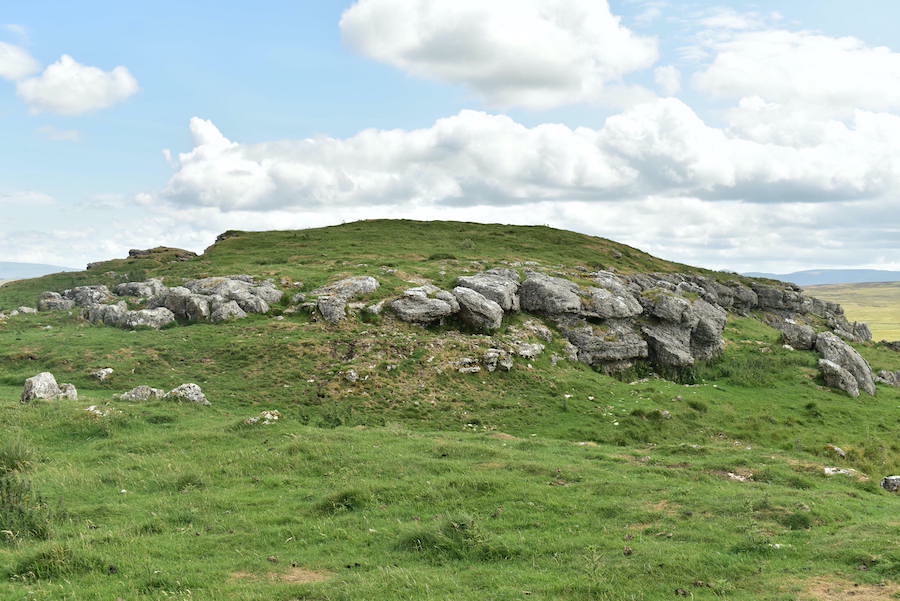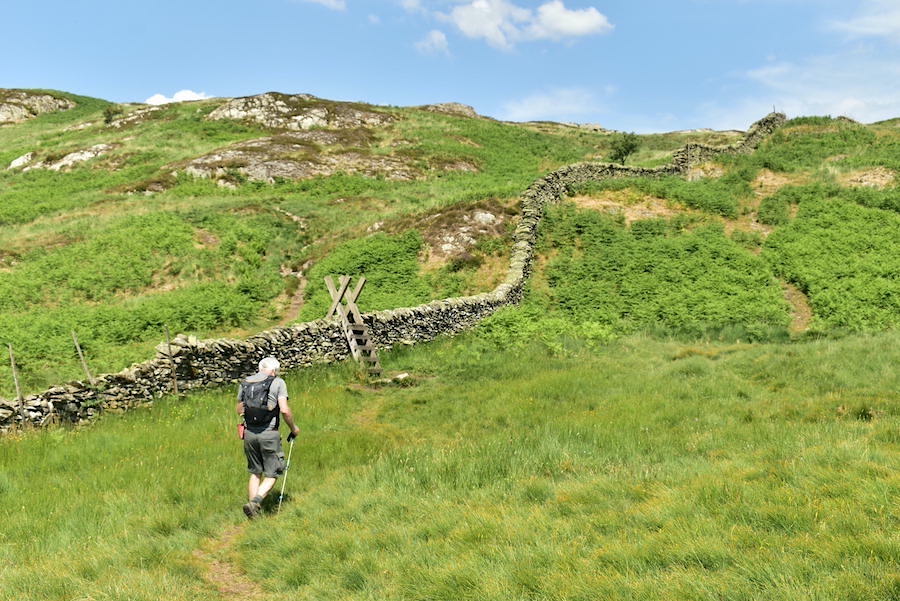Walk date – 23rd August 2023
Distance – 5.75 miles (excluding boat trip)
Weather – Dull, cloudy start but gradually turning sunny and warm, very light breeze
The usual dull grey cloud blanket stared down at us when we glanced out of the window this morning, but as it was forecast to be mostly dry and cloudy and with only a 20% chance of cloud free fell tops we had already decided how our walk today would pan out. We opted to walk the Roehead to Howtown section of the Ullswater Way which we partially did on the return leg of our walk on 17 Nov 2017. The weather on that day was dull and rainy causing us to cut short our walk, thus omitting Howtown, on that occasion with the intention of returning another day and completing this particular section of the Ullswater Way. So, six years later, today we finally got round to it. The morning began with dull cloud but as the morning progressed the cloud gradually began to break up, bits of blue sky started to appear and eventually we had more frequent and longer lasting sunny spells. Lest anyone should think we are suddenly able to miraculously walk on water when looking at the route map I should explain that we returned to Pooley Bridge via one of the Ullswater ‘steamers’, and jolly nice it was too, particularly as by then it had turned into a very sunny and warm afternoon.
Route
Roehead – The Cockpit stone circle – Aik Beck – Swarthbeck Gill- Swarthbank – Howtown – Ullswater – Pooley Bridge – Roehead


Walking up from the roadside parking at Roehead with a view over to a sunny Arthur’s Pike. There is plenty of cloud around at the moment and long distance visibility is not all that good but there are some small blue patches of sky here and there so we are hopeful that the cloud will break eventually.

Long distance views towards the Helvellyn group remain murky although one of the fells behind seems to be in the sunlight. Not definitely sure which one it is though, possibly Green Side above Glenridding.

A little more of Ullswater begins to appear as we continue on up the path from Roehead.

Blencathra begins to appear behind the Mell fells over on the right skyline.

No point in taking any photos when we reached the stone circle as there were too many people, both walkers and cyclists, to have a chance of taking a worthwhile shot so we kept straight on. Over on the left is White Knott, one of the subsidiary humps on Arthur’s Pike which you might encounter on the way to the summit depending on your chosen route. It looks dry enough along here but quite a lot of the path was very wet and muddy thanks to all the rainfall lately.

Dropping down to Aik Beck here where a good flow of water meant splashing through and hoping for the best. As it turned out it wasn’t too deep and didn’t come over the ‘running boards’, which is how I refer to the strips of rubber which encircle the entire boot and cover the joint between the uppers and the soles of our boots and the toecaps. They are properly known as ‘rands’.

Climbing up out of Aik Beck with a look back at one of the small waterfalls.

A sunny spell lands on the fields around Ullswater although Little Mell Fell and Priest’s Crag to the left of it didn’t get a share of it.

White Knott and Arthur’s Pike were doing much better as far as sunshine went.

Hints of sunshine too, here and there, on the fells in front of us. As we were walking along here the last person in a very long line of cyclists came past us, obviously struggling to keep up with the rest of the group. Each little grouping warned us of more to come and thanked us for stepping aside to let them pass although we didn’t have much choice to do anything but given the speed at which they were going. It didn’t seem to occur to any of them to slow down when approaching us.

A lovely view of Ullswater and the surrounding fells from this section of the path, the cloud seems to be breaking up quite well now and we are getting longer spells of sunshine.

The route ahead and, although the bracken is still very abundant and tall, its fronds are beginning to turn brown as the summer (what summer?) inevitably morphs very gradually towards autumn.

Ullwater and its surrounding fields bathed in sunlight as are the northern fells in the distance. Little Mell Fell on the other hand loses out completely, again.

Dropping down towards Auterstone Wood and …..

….. just a little way further down is the ‘Ullswater seat’ where walkers can pause, take a seat and enjoy the views across the lake for a few minutes. The inscription reads ‘Ullswater, that loveliest of lakes curving gracefully into the far distance’.

Passing below Auterstone Crags on the western side of Arthur’s Pike …..

….. with a look back as we pass beyond them. Arthur’s Pike seems to be getting quite a lot of sun this morning.

Approaching Swarthbeck Gill, we could already hear the water rushing down.

The slab bridge over the beck …..

….. and a view looking upstream at the many small waterfalls the beck creates. AW wrote this about Swarthbeck Gill – ‘if it were more accessible it would be one of the showplaces of the district. Here between towering rock walls are beautiful cataracts, but, alas, they are out of reach of the average explorer. The ferny, tree clad lower gorge, however, may (and should) be visited. The prudent venture no further.’ We didn’t venture further up the gill than this but it might be an interesting place to explore when there isn’t so much foliage around if only to see the falls just a little further up. Probably best visited in early spring/late autumn when there are fewer leaves blocking the view.

Passing a derelict barn below Bonscale Pike, one of the trees has made a home for itself inside the barn. Did the growing tree branches push the barn’s roof off or was the barn already roofless and the tree simply took advantage of a sheltered spot in which to grow?

Ullswater, that loveliest of lakes curving gracefully away into the distance.

One of the Ullswater ‘steamers’ coming in from Pooley Bridge making its graceful way towards the Howtown landing stage.

Descending Swarthbank now and heading for the jetty so I took a close up shot of Steel Knotts…..

….. Place Fell …..

….. and Hallin Fell. The steamer has arrived at the jetty and passengers are disembarking, joining the throng of folk already in, on and around the water. Youngsters falling off paddleboards and squealing as warm bodies meet cold water, people fishing off a yacht or dipping nets to see what they might catch. Others begin making their way up the zig-zag road to the hause on their way to walk over one or more of the surrounding fells. Some passengers, having disembarked, seemed somewhat at a loss as to what to do or where to go next. Our intentions are to find somewhere to sit and eat our lunch and while away the next half hour as we wait for the boat from Glenridding to arrive at 12.55 and ferry us over to Pooley Bridge.

Well, we’ve had our lunch and are now waiting for the boat to Pooley. The one in the shot has just off loaded its Howtown passengers and is on its way down to Glenridding. The one we are boarding is now approaching the jetty having stood some way off and waited until this one got under way.

The jetty now being steamer free I took the opportunity to take this shot of Hallin Fell. All the following shots were taken from ‘The Raven’ which rather puzzlingly had a metal image of a stag affixed to the funnel …..

….. Bonscale Pike as we were leaving Howtown…..

….. Steel Knotts …..

….. Hallin Fell …..

…. looking along Fusedale with the landing stage fast receding…..

….. Beda Fell …..

….. Gowbarrow Fell …..

….. another view along Fusedale …..

….. Bonscale Pike …..

….. Swarthbeck Gill …..

….. Arthur’s Pike with Auterstone Crags below the summit …..

….. Little Mell Fell gets its share of the sunshine at last …..

….. Arthur’s Pike and Bonscale Pike …..

….. the waves created by our boat took one of a pair of paddleboarders for an unplanned swim as we approached the jetty at Pooley Bridge. When we disembarked we bought a couple of Magnum ice cream lollies from the shop on the jetty as we knew there would be long queues at the shops in Pooley. True to form Pooley was very crowded and thus all the shops, cafes and pubs were very busy …..

….. so it was nice to leave all the frenzy behind and begin making our way back up to the car at Roehead. This is a look back towards the village as we left. A little further along we crossed the Howtown road and then walked up the lane to Roehead. We passed a lady leading a golden Labrador which was very reluctant to walk more than a few steps before it decided to stop and lie down. As we passed I asked if she had far to go and the reply was Askham. Not a long distance but with a very reluctant dog we were left wondering how long it would take them to get there. She did manage to get it through the gate at the end of the lane and up onto the homeward path across so I hope they made it back to Askham before the daylight went.

Looking back towards Ullswater from the Roehead lane. We’re back at the car, the Labrador is being persuaded through the gate and the afternoon has blossomed into a warm and sunny one with plenty of blue sky overhead. Well, that’s today’s jaunt over and today, Thursday, as I write the sky is cloudless and wall to wall blue with only a light breeze disturbing the leaves on the trees. On the other hand here’s part of today’s forecast for the Lake District from MWIS –
Chance Of Cloud Free Summits?
20%
Sunshine And Air Clarity?
Little or no sunshine. Visibility varied, sometimes very good, but poor in rain.
I think they got it wrong. Again!




























































































































































































































































































































































